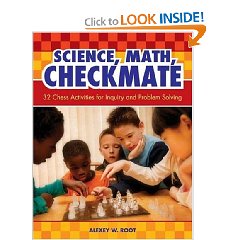Here is an outline of Dr. Alexey Root’s talk 1/31/09 at the Metroplex Math Circle. Please note that we will accept answers for number 6 (the mobility calculation for the King, Queen, Rook, Bishop, and Knight) in the comment section below since Dr. Root did not have a chance to go over the answer to that problem.
1. Dr. Root began with the Knight’s Tour, based on her knight’s tour lesson plan on pages 62-63 of Children and Chess: A Guide for Educators. She was very impressed that Jeffrey Garrity, a math major from the University of Dallas (Irving, Texas) solved it on his first try.
2. Dr. Root had those who played tournament chess and those who knew en passant stand in the front of the room. Those who didn’t have that chess experience stayed seated. Volunteers counted the number of people in each part of the room which lead into a practical math problem of how to group those in attendance so that each group would have one tournament (or en passant-knowledgeable) player.
3. Everyone sat back down in their new groups, as indicated in 2. above.
4. Dr. Root gave an introduction to the role of domination in graph theory and in chess (quoted from her Science, Math, Checkmate: 32 Chess Activities for Inquiry and Problem Solving, pages 37-38 )
 5. Dr. Root taught two chess/math activities. These are domination activities from Science, Math, Checkmate: 32 Chess Activities for Inquiry and Problem Solving (SMC):
5. Dr. Root taught two chess/math activities. These are domination activities from Science, Math, Checkmate: 32 Chess Activities for Inquiry and Problem Solving (SMC):
A. Covering the Board: Rooks (pp. 38-42)
B. Covering the Board: Kings (pp. 42-45)
BREAK TIME.
6. Dr. Root began the Mobility Lesson from pages 79-80 of her Children and Chess: A Guide for Educators. Mobility also has to do with the concept of dominance (coverage of squares). Students calculated the mobility of each piece from the corner and from the center. For example, a queen on an outside edge square can move to 21 squares, but if she is on a central square she can move to 27 squares. What is her average mobility? What is a rook’s average mobility? And so forth for each piece. The pawn is tricky because it moves one way and captures a different way, so you don’t have to calculate the pawn’s mobility unless you want to. Then figure out how this mobility relates to the traditional values listed for the chessmen: P(pawn)=1, N (knight)=3, B (bishop)=3, R(rook)=5, Q(queen)=9, K(king)=infinite but actually around 3.5-4. The answers to this mobility lesson were still being calculated at 4:10 p.m., when the Metroplex Math Circle wrapped up for the day. Please post your answers in the comments section below.
Read Full Post »
 This Saturday we are pleased to welcome back Dr. Jonathan Kane. Dr. Kane’s lecture on vectors promises to be a very good one. Like many of our best lectures, it appears that Dr. Kane will start with a very basic and intuitive explanation of vectors and will build up to the use of vectors as powerful tools for solving complex problems.
This Saturday we are pleased to welcome back Dr. Jonathan Kane. Dr. Kane’s lecture on vectors promises to be a very good one. Like many of our best lectures, it appears that Dr. Kane will start with a very basic and intuitive explanation of vectors and will build up to the use of vectors as powerful tools for solving complex problems. The mathematics segment is designed for students who like to engage in meaningful problem solving activities. It is intended for students who have a particular interest in math competitions as well as for those who wish to explore higher level mathematics well beyond the regular school curriculum.
The mathematics segment is designed for students who like to engage in meaningful problem solving activities. It is intended for students who have a particular interest in math competitions as well as for those who wish to explore higher level mathematics well beyond the regular school curriculum. 5. Dr. Root taught two chess/math activities. These are domination activities from
5. Dr. Root taught two chess/math activities. These are domination activities from 